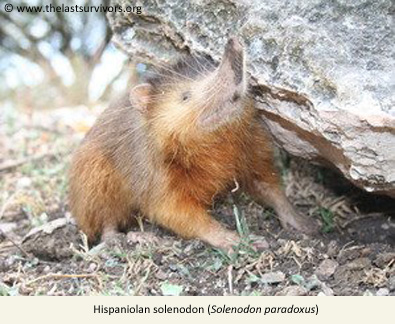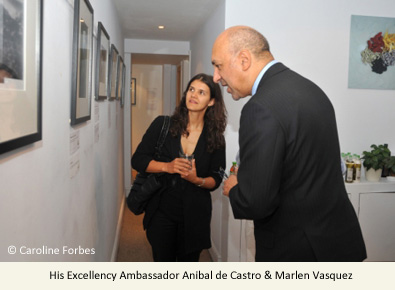Joe Nunez-Mino: An update on all our activities is long overdue, apologies to everyone following our progress.
While I have been away in the UK, Pedro has been kept pretty busy here in the Dominican Republic exploring some new areas (something you can read about further down). While on the subject of exploring new areas, the project has now obtained permits to continue doing research on the solenodon and hutia at the nationwide level rather than being restricted to three of the national parks (which was the situation up until now) thanks to the support of the Ministry for the Environment and Natural Resources.
While I was in the UK we held a very successful event at the London Apothecary Centre which consisted of a series of talks and accompanying photo exhibition. We managed to raise over £1000 for the project and also raised awareness of the project at several levels. We had visitors from the Dominican Republic Ministry of Tourism in addition to representatives from the Dominican Republic London Embassy including his Excellency the ambassador Anibal de Castro. All were very encouraging and pledged their support for the project.
We hope to hold similar events in the future both in the Dominican Republic and the UK. In fact, plans are developing to hold a reception in the Dominican Republic to celebrate the first year of the project as part of the International Year of Biodiversity in October. The UK ambassador to the Dominican Republic, his Excellency Steven Mark Fisher, is to host the event at his residency in Santo Domingo. Further support for the event has also been pledged by the director of the Dominican Republic national zoo, Dr Patricia Toribio.
Let me hand you over to Pedro.
Pedro Marinez: This time it is my intention try to draw a field report of the crew activities during late June through to July which is the time that Joe was taking his vacation back in the UK.
We had a first trip to Parque del Este during this time and set our camp in Boca de Yuma. We soon realised that staying there was a matter of life and death. After almost being eaten alive by a plague of mosquitoes, we decided to move the camp to Guaraguao another one of the park’s cabins in the Bayahibe area. There things went a little bit better although we did not escape the merciless mosquito attack completely but, at least we had electricity and water.
Honestly, not all was that bad during this trip. We found in some areas of the park what we think could be very different evidence from what we have been seeing in the other two parks where we have been working (Parque Jaragua and Parque Sierra de Bahoruco). We definitely need some more conclusive evidence but at the same time the idea that we have encountered something different is very exciting to us.
From Parque del Este we moved to Parque Jaragua where little work had been done there. Parque Jaragua is a different kind of environment, a very dry type of forest with lot of cactus and a tree called Guao, that no matter how far you pass them, you have the feeling that a nest of Amazonian killing ants is heaven.
I hope the next issue brings even better news.
Joe Nunez-Mino: shortly after my return to the Dominican Republic we decided to launch into the field which is where I am writing to you from right now. At the moment I am in very comfortable Punta Cana where we are looking to confirm the presence of solenodon. We have strong evidence that they are here but it is not yet conclusive – camera traps have been strategically placed and the next few days will be crucial. By the way, we have officially launched our twitter site – Https://twitter.com/solenodon_joe which we will update whenever and wherever we have a phone signal. This will give a blow by blow of what the team is up to.
The first five days in the field were spent in Parque del Este where we explored very remote areas in the southern part of the park which can be accessed by boat although this is expensive and our budget does not quite stretch to it. Instead we took the much harder route by foot. It involved six hour treks through blistering hot sun and although mosquitoes and sand flies were a problem they were no where near as unbearable as the previous trip that Pedro took to this area. The park hut that we stayed in, Las Palmillas, is right next door to a very popular tourist site. Tourists are shipped in daily in a variety of boats in order to dine on Lobster. The beaches are spectacular in the area, the forest equally so.
A local park guard accompanied us in our surveys in order to become acquainted and trained in the survey methods we use. We found further ‘different’ evidence just like Pedro and the team had discovered further north although we still don’t have anything conclusive. We will continue our quest to establish the whys and why not’s of the evidence we are finding in this region of the country.
Other news includes the fact that the project has now been listed on the website for the British Chamber of Commerce for the Dominican Republic. Although not directly connected to the project its great to report the fact that the Dominican Republic has now released a stamp with a solenodon on it.
Dr Rebecca Coe who is an educational officer from London Zoo will be arriving in the Dominican Republic next week to work along side Ivelisse Diaz Sosa who heads up the educational department at the national zoo. Jointly they will further develop the educational program that will aim to increase the knowledge and awareness of solenodon and hutia amongst school children at the nation wide level.
We hope not to take so long before the next update but remember you can always follow our progress on facebook or for more regular updates on twitter.
Read previous blogs from The Last Survivors project here, and to support the conservation of EDGE species please donate here.





